The beef cattle show tradition spans well over 100 years in the United States, although the way that exhibitors present cattle has changed tremendously in a century. Youth beef cattle shows often incorporate beef cattle showmanship as part of beef cattle exhibitions. Winning showmanship has become an accolade that many seek to achieve. Doing so takes practice, patience, and a willingness to be coached.
This overview of showmanship techniques should serve as a guide to improving the performance of a showman (also called a handler) as well as the heifer's or steer's placement in its respective class. Practice these tips at least a few times a week for 2 to 3 weeks prior to a show. Calves that are challenging to halter train obviously will need more practice.
Keys for a Successful Handler
The three main areas in which handlers should develop and practice include:
- Animal position
- Handler or showman position
- Poise, posture, and awareness
The Keys to Animal Position are:
- offset the rear legs
- pull the animal into position
- use a show stick on the feet as little as possible
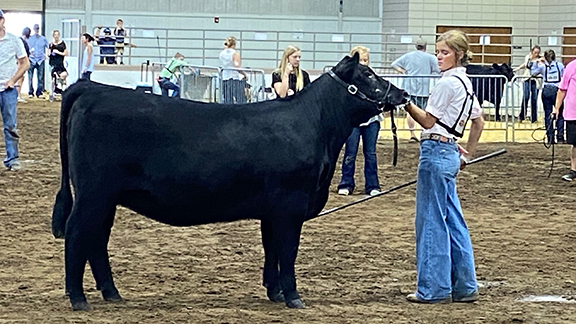
Regardless of a judge's particular emphasis, animal position is always paramount. Figure 1 demonstrates correct feet and leg position. A judge typically views cattle on the animal's right side, also known as the “show side”. It is commonly understood that rear legs should be slightly offset as shown in Figure 1. The show-side hind leg should be directly underneath the pin bone or slightly behind, depending on the animal. The off-side hind leg should be offset underneath.
The amount of separation between feet varies based on the animal's size and need. However, there should be daylight visible between the feet from a profile view. This offset presentation of the back feet improves the profile look of the calf as it is not only a more natural look but also improves levelness of the top and overall eye appeal compared to the rear legs being side by side. Getting cattle to stop and profile with their hind legs offset as described takes practice at home for the best results—maybe a couple of times a week for 3 weeks or more.
One of the main skills necessary for showmanship excellence is pulling the animal into position rather than moving their feet with the show stick (particularly the rear feet). With enough repetition both for the heifer and the handler, it's possible to achieve proper position of the animal's feet and legs while not using a show stick. The calf will be accustomed to the routine of pulling into position over time with age and experience in the show ring. Handlers still are the key component regardless. Prior to arriving at the desired stopping spot, the handler should transition to a reverse walk to watch the animal's position for its last few steps prior to stopping. The handler should not stop and profile abruptly, but rather use a smooth slowing-down process as the animal takes the last few steps prior to stopping.

When all goes as intended, the calf should be presented to the judge with the desired profile view. In those instances when the feet aren't in the desired position, another full step or half a step may be needed. Practicing this at home to perfect the look of your calf's profile will make the showing process better for everyone.
In general, front legs should be positioned directly underneath the heifer's shoulder alignment. Although less emphasis is made on offsetting the front legs, a slight offset as shown in Figure 1 is ideal, particularly for the advanced handler. Occasionally, the handler may need to reposition one of the front feet slightly.
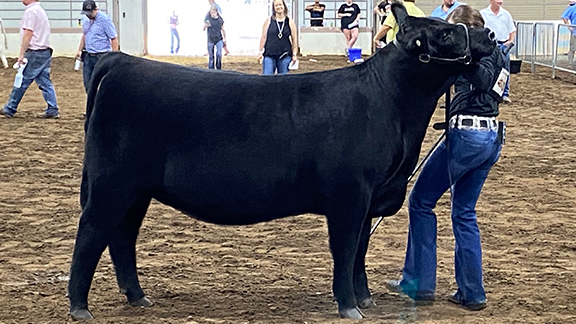
In the example shown in Figure 2, the handler uses the show stick hook just below the dewclaws of the front foot to initiate the animal to reposition. If the foot needs to move back, the handler should also push back slightly on the halter. If the foot should come forward, pull the halter just enough to encourage the heifer to position the foot more forward. If both front feet need to be moved, it may be best to pull the calf a step forward while watching the feet come into position. Older handlers in particular also can use their own feet to help guide a heifer's foot as shown in Figure 2. In Figure 3, the dewclaw is highlighted with a circle, and the handler applies gentle pressure just below the dewclaw (the area identified with an arrow).
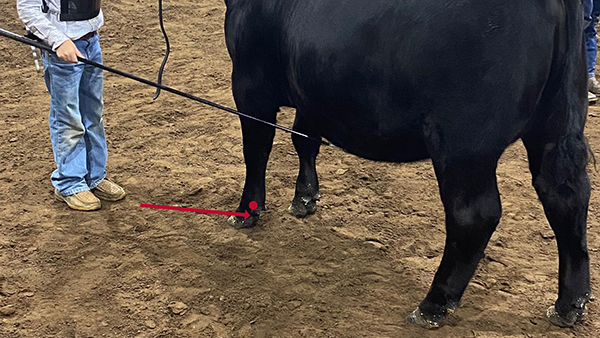
The Keys to Handler or Showman Position are:
- position while standing
- position of hand on the halter
- position while leading
Second to animal position, the handler's position also is important. Oftentimes handler position is used to separate out the top showmen in a showmanship division. The handler should be positioned in front of the nose—but not directly in front—of the heifer. The handler often is just to the side, as demonstrated in Figure 3.
Handler position can change based on personal preference. Still, being in front of the heifer versus beside the head, neck, or shoulder offers a more appealing view of the heifer. It also is understood to be a more professional approach to showmanship. From this angle in Figure 4, the handler's hand position also can be seen. Although hand position may vary slightly, it is generally recommended to hide the hand slightly while holding the halter lead close to the head. This hand position gives the handler good head control, which allows for the head to be either lifted up, pushed toward the judge slightly while on profile, or kept in line with the spine on a rear view.
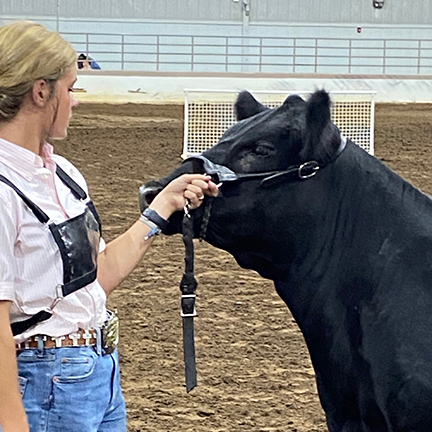
Steer handlers also can pull the head slightly closer to the judge during the time the judge handles the steer's topline for fat thickness. Handlers should find their own comfort zone for where and how to stand to make the most attractive display for the judge.
On the lead, handlers generally should be out in front. This obviously will depend on the calf's own speed. Show cattle that are moving too fast will need to be slowed down and that may require the handler to be beside the heifer in order to better control the animal. Showing while on the lead is likely the most challenging part of showing for some exhibitors. On the stand, cattle often are content to observe their surroundings and be scratched by the show stick. When on the move, cattle may be more tempted to head back to their stalls. Handlers that work with their calf projects often will be better prepared to know their behavioral tendencies.
Another consideration handlers should account for is the judge's position. Exhibitors should move slightly to allow for a front view when the judge makes a front-view approach. Exhibitors also should adjust their position slightly to see the judge if the judge is behind them. Generally, the handler should maintain a line of sight with the judge.
Other considerations include staying in line and allowing for the best possible view of the steer or heifer. Cattle that get out of line are a distraction and cause the ring to become chaotic as the other exhibitors move to get to a similar position. More importantly, exhibitors want to keep their calves in the best possible position for viewing. This includes staying out of corners where the judge would have a difficult time getting a good view. Also be aware of downward slopes or holes. If you encounter them in the show ring, do not stop your calf's front end in those low spots; instead, stop your heifer or steer with their front end level or slightly higher than the rear end of the animal.
Poise, Posture, and Awareness
Although animal position and handler position are critical, once inside the show ring awareness of all aspects of the ring is essential for success. This includes the exhibitor's own posture and poise. Handlers should be focused and exude a poised, competitive spirit (Figure 5). Handlers generally should be standing with a good upright posture rather than a slouched posture.
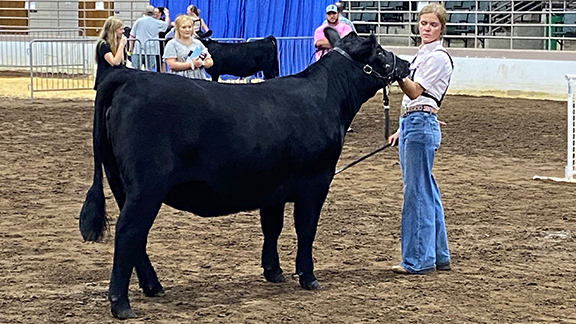
In addition, the handler should be monitoring the following while in the show ring:
- cattle feet position
- judge's location, while routinely keeping eye contact
- distance from other cattle
- calf's topline
- calf's tail
Overall ring awareness is essential to good showmanship. For example, leaving sufficient room in a side-by-side lineup of cattle allows the handler to better manage their calf and allows room for the judge's evaluation. Sufficient room is generally the width of two animals. However, the ring steward may ask you to be closer to maximize space in the ring. Proper awareness of other cattle in the lineup and where to stop are essential.
A handler's understanding of where to go once in the show ring is very important, particularly if they are first in the lineup. This demonstrates a sense of confidence and lets the judge know the exhibitor is competent and competitive. If possible, exhibitors should watch how the show is being conducted within the ring to better understand flow once the handler's class begins.
Awareness of what's going on around the show ring is critically important whether standing or on the lead (Figure 6), and a handler should be careful to watch the cattle ahead of them. This will help handlers understand when to transition to showing on the profile as seamlessly as possible. Mastering ring awareness and when to stop are key concepts to understand when showing in the method described in this article. How much room should you leave between cattle when showing on profile? If room permits, leave enough room to readjust the calf's position. The proper distance is approximately the length of a yearling calf, which is around 6 or 7 ft.
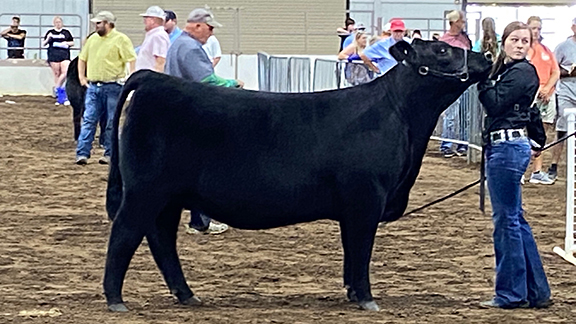
Adjusting toplines and tails are now customary practices in the show ring. Some cattle may need to be “loined” using the show stick on the topline, while others may not. Loining is performed by gently applying a show stick to the loin area of the heifer or steer's spine (Figure 7). Likewise, using a show stick to bring down a lifted tail improves the look of cattle and displays show-ring awareness of your calf. This often is done by gently applying the show stick to the area just beneath the tail (Figure 7). Again, both motions should be gentle with smooth transitions from point A to point B. Loining and tailing in haste may cause the calf to move and the handler to look nervous and hurried.
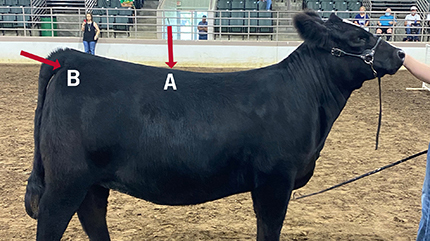
Not all cattle need to be loined. Cattle that are weak-topped may need to be left alone. Holding a head too high can be as detrimental as holding a head to low if the calf's topline looks broken behind the shoulders or loin. Work with a knowledgeable person to evaluate which position helps your calf look its best regarding head position, feet position, loining, tailing, and “getting ears.” If done subtly, getting a calf's ears forward can make the profile view more attractive. This may be done by a whisper that has been practiced while working at home. Loud noises and heavy distractions should not be used.
Summary
In conclusion, showing beef cattle is done well when the handler focuses on calf position as well as their own position relative to the calf while maintaining ring awareness. These basic tips will need to be practiced over time with a calm, confident, and commanding attitude. To be a successful exhibitor, it is helpful to watch more experienced handlers that consistently excel in the showmanship ring.
Status and Revision History
Published on Oct 23, 2023


























































